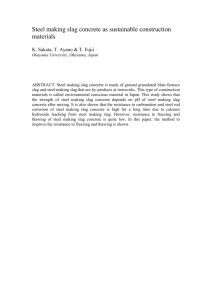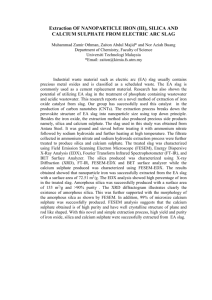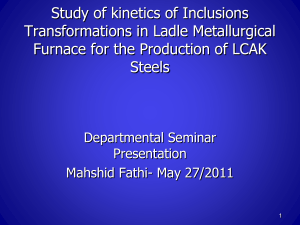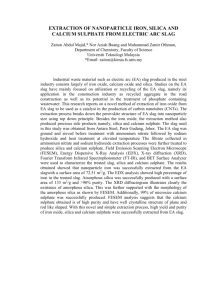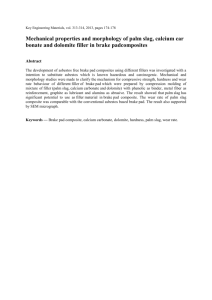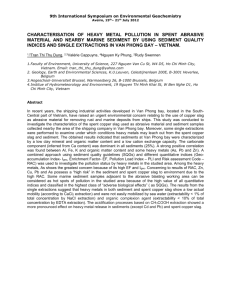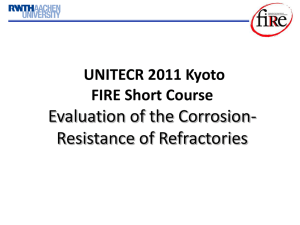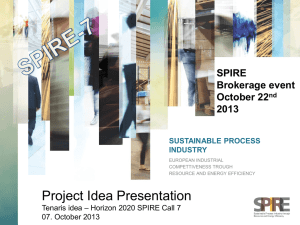Apresentação do PowerPoint - Slag Valorisation Symposium
advertisement
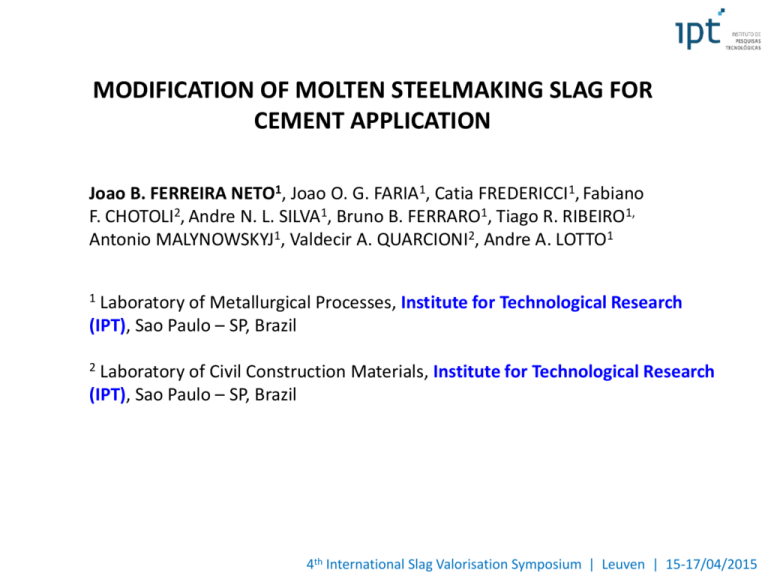
MODIFICATION OF MOLTEN STEELMAKING SLAG FOR CEMENT APPLICATION Joao B. FERREIRA NETO1, Joao O. G. FARIA1, Catia FREDERICCI1, Fabiano F. CHOTOLI2, Andre N. L. SILVA1, Bruno B. FERRARO1, Tiago R. RIBEIRO1, Antonio MALYNOWSKYJ1, Valdecir A. QUARCIONI2, Andre A. LOTTO1 1 Laboratory of Metallurgical Processes, Institute for Technological Research (IPT), Sao Paulo – SP, Brazil 2 Laboratory of Civil Construction Materials, Institute for Technological Research (IPT), Sao Paulo – SP, Brazil 4th International Slag Valorisation Symposium | Leuven | 15-17/04/2015 OUTLINE - Availability of BF slag in Brazil and use of SS slag as alternative for cement industry in Brazil - Effect of cooling rate and chemical composition on slags crystallization - Conclusions dis 4th International Slag Valorisation Symposium | Leuven | 15-17/04/2015 Blast Furnace slag X Steel Slag → Cement Industry in Brazil Near future scenario: There will be a lack of BF slag to supply the demand of cement manufacturing in Brazil The steel production in Brazil has been around 32-34 millions t/y for last ten years. There is not any expectation of increasing X growth of construction industry in Brazil 32,909 31,610 33,782 33,716 32,948 30,901 35,220 34,600 34,163 26,506 Production of crude steel in Brazil (x1.000 t) 2004 2005 2006 2007 2008 2009 2010 2011 2012 2013 Steel slag could be an alternative as cement mineral admixture, partially substituting the BF slag conc I & S (EAF); 8,1 26,6 MT steel x 120 kg SSlag/t steel = 3,2 Mt of Steel Slag (BOF) I & S (BOF); 26,6 (~4 millions t of BF slag) Crude Steel production in Brazil Source: Instituto Aço Brasil Ta 4th International Slag Valorisation Symposium | Leuven | 15-17/04/2015 Objective: Development of autogenous process of liquid Steel Slag modification aiming its application as raw material in the portland cement manufacturing, partially substituting the BF slag BF Slag 41-44 6-7 35-40 10-13 < 1,8 0,8-1,1 1,2-1,4 CaO (%) MgO (%) SiO2 (%) Al2O3 (%) FeO (%) Fe2O3 (%) S (total) P2O5 (%) Basicity (CaO+MgO)/SiO2 Steel Slag (Brazil) 36-46 5-12 10-16 1-4 14-22 13,6 0,1-0,3 1,0-2,5 > 3,0 Technological barriers to be overcome: - Chemical composition modification (decreasing of free CaO and MgO, Fe2O3/FeO and Fe) - Transformation of mineralogical phases (appropriate phases with hydraulic activity for cement production - Low cost by-products/residues must be used as transforming agents - Use of heat content in SSlag for modification process 4th International Slag Valorisation Symposium | Leuven | 15-17/04/2015 Effect of cooling rate and chemical composition on slags crystallization Lab Scale (1 kg modified slag) MgO crucible SS slag + modyfing agents Ceramic mold TC 3 TC 2 TC 1 Slag Cu Chilled plate Water in Water out Slag SS rem ch Glassy layer 4th International Slag Valorisation Symposium | Leuven | 15-17/04/2015 Effect of cooling rate and chemical composition on slags crystallization Lab Scale (1 kg modified slag) Pilot Scale (300 kg modified slag) MgO crucible SS slag + modyfing agents Ceramic mold SS slag + modyfing agents TC 3 TC 2 TC 1 Slag Cu Chilled plate Water in Water out Slag Glassy layer 4th International Slag Valorisation Symposium | Leuven | 15-17/04/2015 XRF BF Lab Scale (1kg) Pilot Scale (300) kg SS SS-M1 SS-M2 SS-M3 SS-M4 SS-M5 *** - 13,6 4,4 0,6 6,0 2,0 3,1 * 0,2 18,3 7,3 2,4 7,2 7,6 13,2 Fe0 (%)** CaO (%) S (%) 41,5 0,7 0,2 38,1 0,1 0,3 38,5 <0,1 <0,1 33,1 0,1 0,9 37,9 0,1 0,3 37,3 <0,1 0,1 34,5 0,1 SiO2 (%) 33,1 9,9 27,5 30,2 27,6 32,2 21,6 Al2O3 (%) 10,5 1,7 2,6 11,5 2,1 4,8 10,7 MgO (%) 7,2 8,6 10,6 13,2 10,8 9,8 10,4 TiO2 (%) 0,6 0,3 0,3 0,2 0,3 0,2 0,3 MnO (%) 0,6 4,4 4,5 2,1 4,4 3,1 3,8 P 2O5 (%) B (%CaO/%SiO2) 0,0 1,3 1,3 3,8 1,5 1,4 0,4 1,1 1,2 1,4 0,8 1,2 1,1 1,6 Fe2O3 (%) FeO (%) Modified Steel Slags 4th International Slag Valorisation Symposium | Leuven | 15-17/04/2015 Blast Furnace Slag XRF Fe2O3 (%) *** XRD (Rietveld) BF - * 0,2 Fe0 (%)** CaO (%) S (%) 41,5 0,7 SiO2 (%) 33,1 Al2O3 (%) MgO (%) TiO2 (%) MnO (%) P 2O5 (%) B (%CaO/%SiO2) 10,5 7,2 0,6 0,6 0,0 1,3 FeO (%) BF Distance from chilled plate 2 mm 5 mm 30 mm Larnite (%) Brownmillerite (%) RO (%) Lime (%) Merwinite (%) 4,6 19,4 2,2 Monticellite (%) Melilite (%) 3,3 95,7 Akermanite (%) 72,0 Gehlenite (%) Amorphous (%) 94,6 5,3 0,1 Slag Cu Chilled plate Water in Water out Obs: Slag remelted in graphite crucible Merwinite, Akermanite, Melilite (solid solution between Akermanite and Gehlenite) Typically found in BF slag cooled slowly 4th International Slag Valorisation Symposium | Leuven | 15-17/04/2015 Cooling curves (experimental x Heat Transferring model) HT Model 20 mm Ceramic mold TC2 – 20 mm Slag HT Model 3,5 mm TC 2 TC 1 TC1 – 3,5 mm HT Model 2 mm Cu Chilled plate HT Model 5 mm Distance from chilled plate (mm) Amorphous (%) Calculated cooling rate (°C/s) (900-1400°C) Water in Water out 2 94,6 3,9 5 5,3 2,6 under cooling rates faster than 4°C/s it would be possible to predict more than 95% of amorphous phase in BF slag 4th International Slag Valorisation Symposium | Leuven | 15-17/04/2015 Steel Slag XRD XRF Fe2O3 (%) *** FeO (%)* 0 SS 13,6 18,3 ** Fe (%) CaO (%) S (%) 0,2 38,1 0,1 SiO2 (%) 9,9 Al2O3 (%) MgO (%) TiO2 (%) MnO (%) P 2O5 (%) B (%CaO/%SiO2) 1,7 8,6 0,3 4,4 1,3 3,8 SS Distante from chilled plate 1 mm 3 mm Larnite (%) 31,2 37,1 Brownmillerite (%) 24,1 26,0 RO (%) 26,3 33,8 Lime (%) 3,8 3,2 Merwinite (%) 2,1 Monticellite (%) Melilite (%) Akermanite (%) Gehlenite (%) Amorphous (%) 11,8 - 5 mm 35,6 38,7 21,5 4,2 - only 11,8% of amorphous phase even close to chilled plate basicity FexOy (can act as nuclei for crystallization) Crystalline phases typically found in steel slags: brownmillerite, larnite, RO phase (solid solution among FeO, MnO, MgO and CaO) and lime Increasing of brownmillerite under slower cooling, since the calcium ferrite, or brownmillerite – Ca2(Al,Fe)2O5) is one of the last phases to crystallize Lime content (3,2 - 4,2%) too high in order to prevent volume soundness 4th International Slag Valorisation Symposium | Leuven | 15-17/04/2015 Steel Slag XRD SS Distance from chilled plate 1 mm 3 mm Larnite (%) 31,2 37,1 Brownmillerite (%) 24,1 26,0 RO (%) 26,3 33,8 Lime (%) 3,8 3,2 Merwinite (%) 2,1 Monticellite (%) Melilite (%) Akermanite (%) Gehlenite (%) Amorphous (%) 11,8 - 5 mm 35,6 38,7 21,5 4,2 - Simulation of cooling liqliq In ra Steel Slag RO CaO (%) SiO2 (%) P2O5 (%) MgO (%) Al2O3 (%) FeO* (%) MnO (%) TiO2 (%) Fe 2O3 (%) Phases BM RO C2 S BM C2 S C2 S RO BM C2 S C2S 67,9 32,2 - - - - - - - C2S 64,8 32,9 2,2 - - - - - - C2S 66,4 32 1,6 - - - - - - C2S 65,1 32,5 2,4 - - - - - - C2S BM BM BM CaO/RO CaO/RO 65,9 49,9 52,1 49,7 80,4 80,8 31 - 1 - - 6,1 4,8 6,2 - - - 2,8 1,3 2,1 - 3,6 41,2 41,8 41,9 - 1,4 1,8 11,5 11,3 6,6 6,1 (*) Fe as FeO RO phase: CaO RO RO RO RO/CaO RO/CaO RO wt (%) 3,8 6,8 7,5 3,6 3 3,1 6,5 MgO at (%) 3,9 7 8,2 3,7 3,1 3,2 6,8 wt (%) 31,6 28,9 19,4 38,2 38,5 42,4 26 FeO at (%) 44,7 41,3 29,5 51,9 52,3 56,3 38 wt (%) 53,4 53,4 61 49,3 48,5 46,3 57,2 MnO at (%) 42,4 42,8 52 37,8 37 34,5 47 CaO (wt %) MgO (wt %) FeO (wt %) MnO (wt %) 7,5 25,4 54,1 13 wt (%) 11,2 10,9 12 8,7 10,1 8,3 9,8 RO calculated by mass balance (XRD Rietveld and XRF) MgO/FeO (at %): – 0,6 and 1,6 MgO/FeO at (%) 9 8,9 10,4 6,7 7,8 6,3 8,1 Volume Soundness Modified Steel Slag (SS-M1) XRF Fe2O3 (%) *** FeO (%)* 0 ** XRD SS-M1 4,4 7,3 Fe (%) CaO (%) S (%) SiO2 (%) 0,3 38,5 <0,1 27,5 Al2O3 (%) MgO (%) TiO2 (%) MnO (%) P 2O5 (%) B (%CaO/%SiO2) 2,6 10,6 0,3 4,5 1,5 1,4 Distante from chilled plate 1 mm 5 mm 30 mm Larnite (%) Brownmillerite (%) RO (%) 6,5 5,8 7,3 Lime (%) Merwinite (%) 69,0 65,7 68,9 Monticellite (%) Melilite (%) Akermanite (%) Gehlenite (%) Amorphous (%) 24,5 28,5 23,8 Amorphous phase (did not change with the distance from the mold bottom) Basicity (1,4) compared to the steel slag (B = 3,8) RO (FexOy reduction - modifying agents and partially transferring of MgO from RO phase to the merwinite) MgO stabilized as Merwinite Free lime eliminated 4th International Slag Valorisation Symposium | Leuven | 15-17/04/2015 Modified Steel Slag (SS-M1) Distance from chilled plate 1 mm 5 mm 30 mm Larnite (%) Brownmillerite (%) RO (%) 6,5 5,8 7,3 Lime (%) Merwinite (%) 69,0 65,7 68,9 Monticellite (%) Melilite (%) Akermanite (%) Gehlenite (%) Amorphous (%) 24,5 28,5 23,8 Simulation of cooling liq 4th International Slag Valorisation Symposium | Leuven | 15-17/04/2015 Modified Steel Slag (SS-M1) Phases MW MW MW MW MW Amorphous Amorphous Amorphous Amorphous Amorphous Amorphous Amorphous Amorphous (ẋ) Merwinite glassy phase RO MgO (%) CaO (%) SiO2 (%) MnO (%) Fe2O3* (%) Al2O3 (%) TiO2 (%) 7,5 7,8 7,5 6,4 7,5 0,8 1 0,7 0,7 0,5 0,5 0,7±0,3 57,3 35,2 57,2 35 53,1 33,3 3,3 54,2 32,7 3,3 57,5 35 28,7 28 9,5 33 29,8 10,6 30,2 28,9 14,3 33,3 26,8 9,4 31,6 28,1 10 32,7 30,7 7,6 33,1 30,4 9,5 31,8±1,7 29,0±1,4 10,1±2,1 2,7 3,4 17 13,4 12,5 11,3 14,3 10 12,5 15,6 13,3 13,6 16,8 9,8 14,6 9,6 14,4±1,7 11,9±2,3 RO phase: CaO glassy phase Merwinite RO wt (%) 1,3 2 1,5 1,8 1,9 1,8 1,5 1,7 2,4 1 1,3 at (%) 1,5 2,3 1,7 2,1 2 2,2 1,8 2 2,8 1,1 1,3 2,6 1,7 1,6 2 2,7 1,8 2,3 2,1±0,4 (*) Fe as Fe2O3 MgO wt (%) 16,5 12,8 15,7 11,5 26,6 7 9,5 12,6 10,4 16,9 29,5 FeO at (%) 25,9 20,6 24,8 18,7 39 11,7 15,6 20,3 17 26,5 42,6 wt (%) 66,1 67,9 66,8 67,3 57,8 73,2 71,3 67,6 71,2 66,9 53 MnO at (%) 58,2 61,3 59,2 61,3 47,6 68,7 65,8 61,1 65,3 58,8 42,9 wt (%) 16,1 17,2 16 19,4 13,7 18 18 18,2 15,9 15,3 16,1 at (%) 14,4 15,7 14,4 17,9 11,4 17,2 16,8 16,7 14,8 13,6 13,2 MgO/FeO (at %): – 0,2 and 0,45 MgO/FeO Could prevent volume soundness Modified Steel Slag (SS-M2) XRF XRD Fe2O3 (%) SS-M2 0,6 *** * 2,4 ** Fe (%) CaO (%) S (%) <0,1 33,1 0,1 SiO2 (%) 30,2 Al2O3 (%) MgO (%) TiO2 (%) MnO (%) P 2O5 (%) B (%CaO/%SiO2) 11,5 13,2 0,2 2,1 0,4 1,1 FeO (%) 0 basicity and Distante from chilled plate 2 mm 6 mm 30 mm Larnite (%) Brownmillerite (%) RO (%) Lime (%) Merwinite (%) 3,3 6,5 2,4 Monticellite (%) 25,6 29,7 Melilite (%) Akermanite (%) 4,9 54,0 55,1 Gehlenite (%) 13,9 12,3 Amorphous (%) 91,2 0,5 Fe2+ and Fe3+ compared to slag SS-M1 and Al2O3 (%) 11,5% Stabilization of the glassy phase (close to the chilled plate) - similar to the BF slag ( Basicity and Al2O3 RO phase eliminated, MgO stabilized in phases with lower CaO/SiO2 ratio than merwinite (3CaO.MgO.2SiO2), such as monticellite (CaO.MgO.SiO2) and akermanite (2CaO.MgO.2SiO2) Gehlenite formed in slag SS-M2 ( Al2O3) 4th International Slag Valorisation Symposium | Leuven | 15-17/04/2015 Amorphous (%) X Distance from Chilled Plate > 4°C/s (> 95% amorphous) 100 90 Amorphous layer (SS-M2) Amorphous |(%) 80 70 60 BF 50 (SS-M2) 40 SS-M1 30 20 ss 10 0 0 1 2 3 4 5 6 7 Distance from Chilled plate (mm) SS–M2 similar to BF slag (> 4°C – HT model - > 95% amorphous phase) SS – no glassy even under high cooling rates SS-M1 lower quantity of amorphous than BF or SS-M2 and independent from cooling rate Modified Steel Slag (SS-M3) – 300 kg (reproduction of SS-M1 – larger scale) XRF XRD SS-M3 Fe2O3 (%) *** FeO (%)* 0 SS-M3 6,0 7,2 ** Fe (%) CaO (%) S (%) 0,9 37,9 0,1 SiO2 (%) 27,6 Al2O3 (%) MgO (%) TiO2 (%) MnO (%) 2,1 10,8 0,3 4,4 P 2O5 (%) B (%CaO/%SiO2) 1,2 1,4 Cooling conditions Larnite (%) Brownmillerite (%) RO (%) Lime (%) Merwinite (%) Monticellite (%) Melilite (%) Akermanite (%) Gehlenite (%) Amorphous (%) NC 4,0 3,4 3,2 SB 5,7 3,8 7,8 29,6 30,0 47,2 11,1 6,6 22,3 23,0 NC. Natural cooling. SB. Cooling by steel balls No significant differences between SS-M1 and SS-M3 Amorphous phase similar of SS-M1 and unaffected by cooling rate conditions (by NC or SB) RO compared to the SS slag MgO stabilized as XCaO.YSiO2.ZMgO: Merwinite, Akermanite and Monticellite Free lime eliminated 4th International Slag Valorisation Symposium | Leuven | 15-17/04/2015 Modified Steel Slag (SS-M4) – 300 kg ( B (%CaO/%SiO2) FexOy reduction) XRF XRD Fe2O3 (%) *** FeO (%)* 0 SS-M4 2,0 7,6 ** Fe (%) CaO (%) S (%) 0,3 37,3 <0,1 SiO2 (%) 32,2 Al2O3 (%) MgO (%) TiO2 (%) MnO (%) P 2O5 (%) B (%CaO/%SiO2) 4,8 9,8 0,2 3,1 0,8 1,2 Cooling rate (water quenching) SS-M4 Cooling conditions Larnite (%) Brownmillerite (%) RO (%) Lime (%) Merwinite (%) Monticellite (%) Melilite (%) Akermanite (%) Gehlenite (%) Amorphous (%) NC 4,6 SB 10,9 55,7 34,9 42,8 17,9 9,5 - 10,9 11,5 WQ 37,2 62,8 NC. Natural cooling. SB. Cooling by steel balls. WQ. Water quenching amorphous RO eliminated MgO stabilized as XCaO.YSiO2.ZMgO: Merwinite, Akermanite and Monticellite Free lime eliminated 4th International Slag Valorisation Symposium | Leuven | 15-17/04/2015 Modified Steel Slag (SS-M4) SS-M4 Cooling conditions Larnite (%) Brownmillerite (%) RO (%) Lime (%) Merwinite (%) Monticellite (%) Melilite (%) Akermanite (%) Gehlenite (%) Amorphous (%) NC 4,6 SB 10,9 55,7 34,9 42,8 17,9 9,5 - 10,9 WQ NC. Natural cooling 11,5 WQ. Water quenching 37,2 62,8 Simulation of cooling NC. Natural cooling. SB. Cooling by steel balls. WQ. Water quenching FactSage™ predicts a decreasing of merwinite phase and an increasing of monticellite phase under slowly cooling (natural cooling), behavior also observed in slag SS-M3 4th International Slag Valorisation Symposium | Leuven | 15-17/04/2015 Modified Steel Slag (SS-M5) – 300 kg ( B (%CaO/%SiO2), FexOy reduction, Al2O3 ) XRF XRD Fe2O3 (%) *** FeO (%)* 0 ** SS-M5 3,1 SS-M5 13,2 Fe (%) CaO (%) S (%) 0,1 34,5 0,1 SiO2 (%) 21,6 Al2O3 (%) MgO (%) TiO2 (%) MnO (%) P 2O5 (%) B (%CaO/%SiO2) 10,7 10,4 0,3 3,8 1,1 1,6 Cooling conditions Larnite (%) Brownmillerite (%) RO (%) Lime (%) Merwinite (%) Monticellite (%) Melilite (%) Akermanite (%) Gehlenite (%) Amorphous (%) SB 12,1 16,5 37,4 32,1 1,9 b. Cooling by steel balls Larnite (hydraulic activity) Al2O3 in Gehlenite MgO stabilized as Merwinite and RO Free lime eliminated 4th International Slag Valorisation Symposium | Leuven | 15-17/04/2015 75% of ordinary Portland cement and 25% of slag SS-M4 and SS-M5 - No volume soundness (under cold or hot water) – ISO EN 196-3 - Autoclave test (ASTM C 151): Expansion 10X lower (0,04% - M4 or 0,07% - M5) than 75% cement and 25% SS slag (0,44%) Slag can be considered stabilized - Accumulated Heat (72 h) of cement sample with 25% SS-M5: 314 J/g > 299 J/g (75% cement and 25% BF slag) Compressive Strength Compressive Strenght (MPa) 45 41 37.7 40 35 30 Specified Strengths Standard NBR 11578 (similar to EN 197-1) 32 29.9 3d 25 20 20 7d 28d 15 10 10 5 0 75% CPV + 25% SS-M5 CPII-E 4th International Slag Valorisation Symposium | Leuven | 15-17/04/2015 Conclusions - Only under cooling rates higher than 4°C/s was possible to achieve more than 95% of glassy phase in blast furnace slag. - The crystalline fraction of BF slag showed phases: akermanite, merwinite and melilite, which are typically found in BF slags cooled under slow rates. - The SSlag was mostly crystalline, even under fast cooling, showing phases typically found in this type of slag: brownmillerite, larnite, RO phase and lime. It also showed an increasing of brownmillerite under slower cooling, since the calcium ferrite or brownmillerite is one of the last phases to crystallize. - Higher silica and alumina and lower iron oxides in modified slags contributed to the glassy phase formation under fast cooling. Furthermore, the amount of RO phase decreased as consequence of iron oxides reduction as well as MgO stabilization in merwinite, monticellite and arkemanite. - MgO/FeO ratio of RO phase in modified slags are lower than MgO/FeO ratio of RO phase in SSlag, decreasing a possible expansion effect of RO phase. 4th International Slag Valorisation Symposium | Leuven | 15-17/04/2015 Conclusions - The stabilization of modified slags was demonstrated by volume soundness test carried out under cold and hot water, which did not show any expansion, or by low expansion (0,04 and 0,07%) observed in tests carried out in autoclave (ASTM C 151) with cement samples produced by a mixture between 75% of ordinary cement and 25% of modified slags. - The cement produced with this mixture generated an accumulated heat of 314 J/g in 72h, while the same mixture based on BF slag resulted in 299 J/g. The compressive strength in 3, 7 and 28 days were 29,9 MPa; 37,7 MPa and 41 MPa, respectively, values higher than minimum specified in the same ages according to standard NBR 11578. 4th International Slag Valorisation Symposium | Leuven | 15-17/04/2015 Thank you! Contact: João Batista Ferreira Neto Laboratory of Metallurgical Processes Institute for Technological Research - IPT Sao Paulo - Brazil Tel.: +55 11 3767.4244 jbfn@ipt.br 4th International Slag Valorisation Symposium | Leuven | 15-17/04/2015 Heat transferring CFD model • Developed in COMSOL Multiphysicstm software; • It was considered a 2D axisymmetric geometry for the assembly; • The mesh element size was less than 1 mm; • The physical properties of the slag was estimated according with Mills et al (2011)[1]; • Boundary conditions: • – There is heat loss by radiation in the top of the geometry and by natural convection in the extern walls; – At initial time, the temperature of the slag was set to 1500 – 1600 °C depending on the slag condition. The temperature of the mold and cooper plate was set to 600 °C. The contact between the slag and the cooper plate was adjusted for heat transferring, considering a convection coefficient of 200 W/m²°C. This coeficient was obtained by comparision with experimental data; Fig A . Ceramic mold fixed over a copper plate cooled by water [1] K. Mills, L. Yuan and R. Jones, "Estimating the physical properties of slags," The Journal of The Southern African Institute of Mining and Metallurgy, vol. 111, pp. 649-658, 2011 Heat transferring model Fig B . Model simulation and experimental data for BF slag for geometry A. Fig C . Model simulation and experimental data for BF slag for geometry B. Slags BFSin o Tab. 1 Chemical compositions of slags /%, mass CaO S SiO2 Al2O3 MgO TiO2 MnO Fe2O3 FeO Fe P2O5 CaOf MgOf 0.25 --- --- 41.1 1.6 32.9 11.2 7.1 0.8 0.7 <0.1 <0.1 --- 11.3 19.4 0.4 37.7 0.1 10.3 2.6 9.4 0.5 4.1 1.2 5.7 3.8 13.6 4.4 0.6 6.0 2.0 3.1 0.2 18.3 7.3 2.4 7.2 7.6 13.2 0.2 0.3 <0.1 0.9 0.3 0.1 41.5 38.1 38.5 33.1 37.9 37.3 34.5 0.7 0.1 <0.1 0.1 0.1 <0.1 0.1 33.1 9.9 27.5 30.2 27.6 32.2 21.6 10.5 1.7 2.6 11.5 2.1 4.8 10.7 7.2 8.6 10.6 13.2 10.8 9.8 10.4 0.6 0.3 0.3 0.2 0.3 0.2 0.3 0.6 4.4 4.5 2.1 4.4 3.1 3.8 <0.1 1.3 1.5 0.4 1.2 0.8 1.1 0.1 0.2 0.1 0.1 0.3 0.2 0.1 <0.1 0.1 0.1 <0.1 <0.1 <0.1 0.1 natura SSin natura BFS SS SS-M1 SS-M2 SS-M3 SS-M4 SS-M5 BF Slag Intensity (a.u.) ZnO Akermanite Merwinite Melilite BF - 2mm BF - 5 mm BF - 30 mm 15 20 25 30 35 40 45 50 55 60 65 70 SS Slag C2S Brownmillerite RO CaO Intensity (a.u.) SS - 1 mm SS - 3 mm SS - 5 mm 15 20 25 30 35 40 45 50 55 60 65 70 Modified Steel Slag (SS-M1) Intensity (a.u.) ZnO Merwinite RO Periclase 15 20 25 SSM1 - 1mm SSM1- 5mm SSM1 - 30 mm 30 35 40 45 50 55 60 65 70 75 Modified Steel Slag (SS-M2) Intensity (a.u.) ZnO Akermanite Monticellite Merwinite Gehlenite SSM2 - 2 mm SSM2 - 6 mm SSM2 - 30 mm 15 20 25 30 35 40 45 50 55 60 65 70
